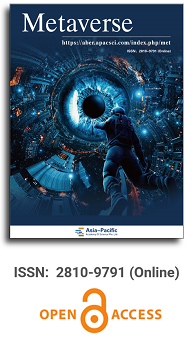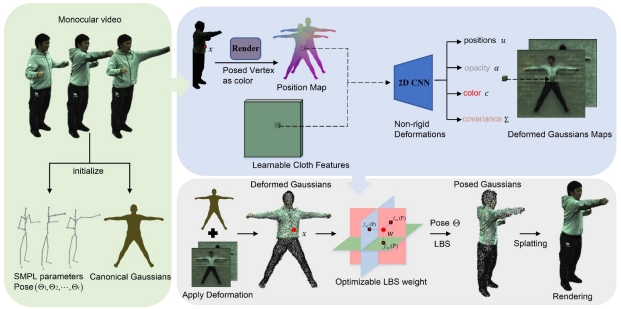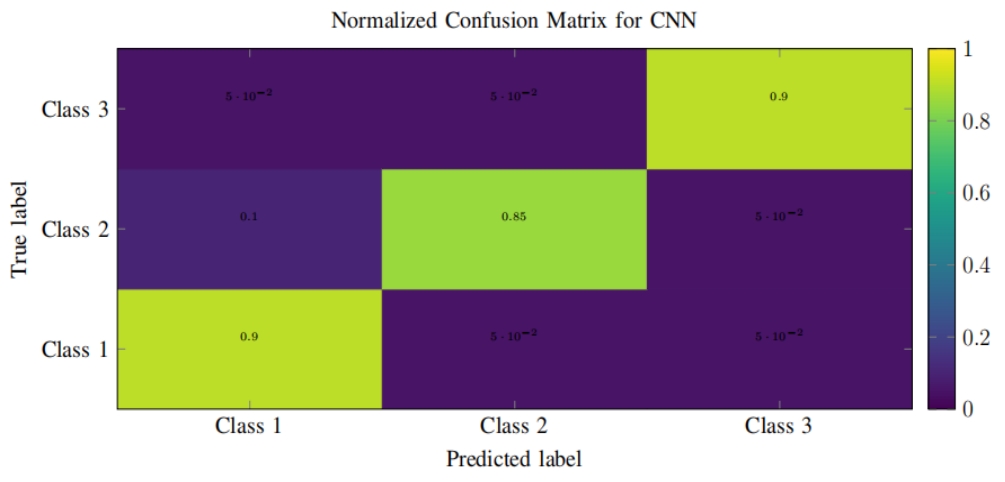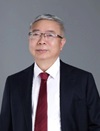
Asia Pacific Academy of Science Pte. Ltd. (APACSCI) specializes in international journal publishing. APACSCI adopts the open access publishing model and provides an important communication bridge for academic groups whose interest fields include engineering, technology, medicine, computer, mathematics, agriculture and forestry, and environment.



Individuality and the collective in AI agents: Explorations of shared consciousness and digital homunculi in the metaverse for cultural heritage
Vol 4, Issue 2, 2023
Download PDF
Abstract
The confluence of extended reality (XR) technologies, including augmented and virtual reality, with large language models (LLM) marks a significant advancement in the field of digital humanities, opening uncharted avenues for the representation of cultural heritage within the burgeoning metaverse. This paper undertakes an examination of the potentialities and intricacies of such a convergence, focusing particularly on the creation of digital homunculi or changelings. These virtual beings, remarkable for their sentience and individuality, are also part of a collective consciousness, a notion explored through a thematic comparison in science fiction with the Borg and the Changelings in the Star Trek universe. Such a comparison offers a metaphorical framework for discussing complex phenomena such as shared consciousness and individuality, illuminating their bearing on perceptions of self and awareness. Further, the paper considers the ethical implications of these concepts, including potential loss of individuality and the challenges inherent to accurate representation of historical figures and cultures. The latter necessitates collaboration with cultural experts, underscoring the intersectionality of technological innovation and cultural sensitivity. Ultimately, this chapter contributes to a deeper understanding of the technical aspects of integrating large language models with immersive technologies and situates these developments within a nuanced cultural and ethical discourse. By offering a comprehensive overview and proposing clear recommendations, the paper lays the groundwork for future research and development in the application of these technologies within the unique context of cultural heritage representation in the metaverse.
Keywords
References
- Lee H. The rise of ChatGPT: Exploring its potential in medical education. Anatomical Sciences Education 2023. doi: 10.1002/ase.2270
- Zhang X, Yang D, Yow CH, et al. Metaverse for cultural heritages. Electronics 2022; 11(22): 3730. doi: 10.3390/electronics11223730
- Garon J. A practical introduction to generative AI, synthetic media, and the messages found in the latest medium. Available online: https://papers.ssrn.com/sol3/papers.cfm?abstract_id=4388437 (accessed on 6 November 2023).
- Gill SS, Kaur R. ChatGPT: Vision and challenges. Internet of Things and Cyber-Physical Systems 2023; 3: 262–271. doi: 10.1016/j.iotcps.2023.05.004
- Albahri AS, Duhaim AM, Fadhel MA, et al. A systematic review of trustworthy and explainable artificial intelligence in healthcare: Assessment of quality, bias risk, and data fusion. Information Fusion 2023; 96: 156–191. doi: 10.1016/j.inffus.2023.03.008
- Lee W, Lee DH. Cultural heritage and the intelligent Internet of Things. Journal on Computing and Cultural Heritage 2019; 12(3): 1–14. doi: 10.1145/3316414
- Liu Y, Han T, Ma S, et al. Summary of ChatGPT/GPT-4 research and perspective towards the future of large language models. arXiv 2023; arXiv:2304.01852. doi: 10.1016/j.metrad.2023.100017
- Latif E, Mai G, Nyaaba M, et al. Artificial general intelligence (AGI) for education. arXiv 2023; arXiv:2304.12479. doi: 10.48550/arXiv.2304.12479
- Ray PP. ChatGPT: A comprehensive review on background, applications, key challenges, bias, ethics, limitations and future scope. Internet of Things and Cyber-Physical Systems 2023; 3: 121–154. doi: 10.1016/j.iotcps.2023.04.003
- Inamura T. Digital twin of experience for human-robot collaboration through virtual reality. International Journal of Automation Technology 2023; 17(3): 284–291. doi: 10.20965/ijat.2023.p0284
- Falandays JB, Kaaronen RO, Moser C, et al. All intelligence is collective intelligence. Journal of Multiscale Neuroscience 2023; 2(1): 169–191. doi: 10.56280/1564736810
- Gaudenzi S. The Living Documentary: From Representing Reality to Co-Creating Reality in Digital Interactive Documentary [PhD thesis]. Goldsmiths, University of London; 2013.
- Ng SL, Kinsella EA, Friesen F, Hodges B. Reclaiming a theoretical orientation to reflection in medical education research: A critical narrative review. Medical Education 2015; 49(5): 461–475. doi: 10.1111/medu.12680
- Tzortzaki, D. Museums and virtual reality: Using the CAVE to simulate the past. Digital Creativity 2001; 12(4): 247–251. doi: 10.1076/digc.12.4.247.3216
- Roussou M. Immersive interactive virtual reality in the museum. Available online: https://www.researchgate.net/profile/Maria-Roussou-2/publication/2861971_Immersive_Interactive_Virtual_Reality_in_the_Museum/links/0c9605192924ee109d000000/Immersive-Interactive-Virtual-Reality-in-the-Museum.pdf (accessed on 6 November 2023).
- Christou C. Virtual reality in education. In: Tzanavari A, Tsapatsoulis N (editors). Affective, Interactive and Cognitive Methods for E-Learning Design: Creating an Optimal Educational Experience. Information Science Publishing; 2010. pp. 228–243.
- Favro D. In the eye of the beholder: VR models and academia. In: Haselberger L, Humphrey J (edotors). Imaging Ancient Rome: Documentation, Visualization, Imagination. Journal of Roman Archaeology; 2006. pp. 321–334.
- Clini P, Ruggieri L, Angeloni R, Sassob M. Interactive immersive virtual museum: Digital documentation for interaction. Available online: https://isprs-archives.copernicus.org/articles/XLII-2/251/2018/isprs-archives-XLII-2-251-2018.pdf (accessed on 6 November 2023).
- Huaman EMR, Aceituno RGA, Sharhorodska O. Application of virtual reality and gamification in the teaching of art history. In: Zaphiris P, Ioannou A (editors). Learning and Collaboration Technologies. Ubiquitous And Virtual Environments for Learning and Collaboration (Lecture Notes in Computer Science). Springer, Cham; 2019. pp. 220–229.
- Chandler T, Clulow A. Modeling virtual Angkor: An evolutionary approach to a single urban space. IEEE Computer Graphics and Applications 2020; 40(3): 9–16. doi: 10.1109/MCG.2020.2982444
- Valk A, Mi X, Schick AL. Making Virtual Reality a Reality: Designing Educational Initiatives in Libraries with Emerging Technologies. Bloomsbury Publishing USA; 2023.
- Balhara S, Gupta N, Alkhayyat A, et al. A survey on deep reinforcement learning architectures, applications and emerging trends. Available online: https://ietresearch.onlinelibrary.wiley.com/doi/pdf/10.1049/cmu2.12447 (accessed on 6 November 2023).
- Strich F, Mayer AS, Fiedler M. What do I do in a world of artificial intelligence? Investigating the impact of substitutive decision-making AI systems on employees’ professional role identity. Journal of the Association for Information Systems 2021; 22(2): 9.
- Zall R, Kangavari MR. Comparative analytical survey on cognitive agents with emotional intelligence. Cognitive Computation 2022; 14(4): 1223–1246.
- Budhwar P, Malik A, De Silva MT, Thevisuthan P. Artificial intelligence–challenges and opportunities for international HRM: a review and research agenda. The International Journal of Human Resource Management 2022; 33(6): 1065–1097.
- Liu-Thompkins Y, Okazaki S, Li H. Artificial empathy in marketing interactions: Bridging the human-AI gap in affective and social customer experience. Journal of the Academy of Marketing Science 2022; 50(6): 1198–1218.
- Singh A, Chouhan T. Artificial intelligence in HRM: Role of emotional–social intelligence and future work skill. In: The Adoption and Effect of Artificial Intelligence on Human Resources Management, Part A. Emerald Publishing Limited; 2023. pp. 175–196.
- Selvaraj C, Chandra I, Singh SK. Artificial intelligence and machine learning approaches for drug design: Challenges and opportunities for the pharmaceutical industries. Molecular Diversity 2021; 26(3): 1893–1913. doi: 10.1007/s11030-021-10326-z
- Jeste DV, Graham SA, Nguyen TT, et al. Beyond artificial intelligence: Exploring artificial wisdom. International Psychogeriatrics 2020; 32(8): 993–1001. doi: 10.1017/S1041610220000927
- Samsonovich AV. Socially emotional brain-inspired cognitive architecture framework for artificial intelligence. Cognitive Systems Research 2020; 60: 57–76. doi: 10.1016/j.cogsys.2019.12.002
- Picard RW, Papert S, Bender W, et al. Affective learning—A manifesto. BT Technology Journal 2004; 22(4): 253–269. doi: 10.1023/B:BTTJ.0000047603.37042.33
- Li Y, Jiang Y, Tian D, et al. AI-enabled emotion communication. IEEE Network 2019; 33(6): 15–21. doi: 10.1109/MNET.001.1900070
- Khachane MY. Organ-based medical image classification using support vector machine. International Journal of Synthetic Emotions 2017; 8(1): 18–30. doi: 10.4018/IJSE.2017010102
- Pusztahelyi R. Emotional AI and its challenges in the viewpoint of online marketing. Curentul Juridic 2020; 81(2): 13–31.
- Cominelli L, Hoegen G, De Rossi D. Abel: Integrating humanoid body, emotions, and time perception to investigate social interaction and human cognition. Applied Sciences 2021; 11(3): 1070. doi: 10.3390/app11031070
- Liu-Thompkins Y, Okazaki S, Li H. Artificial empathy in marketing interactions: Bridging the human-AI gap in affective and social customer experience. Journal of the Academy of Marketing Science 2022; 50(6): 1198–1218. doi: 10.1007/s11747-022-00892-5
- Wortman B, Wang JZ. HICEM: A high-coverage emotion model for artificial emotional intelligence. arXiv 2022; arXiv:2206.07593. doi: 10.48550/arXiv.2206.07593
- Marcos S, García Peñalvo FJ, Vázquez Ingelmo A. Emotional AI in healthcare: A pilot architecture proposal to merge emotion recognition tools. In: Proceedings of the Ninth International Conference on Technological Ecosystems for Enhancing Multiculturality (TEEM'21); 26–29 October 2021; Barcelona Spain. pp. 342–349.
- Huh JH. Seo YS. Understanding Edge computing: Engineering evolution with artificial intelligence. IEEE Access 2019; 7: 164229–164245. doi: 10.1109/ACCESS.2019.2945338
- Andersson R. The bioeconomy and the birth of a “new anthropology”. Cultural Anthropology 2022; 37(1): 37–44. doi: 10.14506/ca37.1.06
- Naddaf Y. Game-Independent AI Agents for Playing Atari 2600 Console Games [Master’s thesis]. University of Alberta; 2010.
- Liu J, Togelius J, Pérez-Liébana D, Lucas SM. Evolving game skill-depth using general video game AI agents. In: Proceedings of the 2017 IEEE Congress on Evolutionary Computation (CEC); 5–8 June 2017; Donostia, Spain. pp. 2299–2307.
- Holmgard C, Liapis A, Togelius J, Yannakakis GN. Generative agents for player decision modeling in games. In: Proceedings of the 9th International Conference on the Foundations of Digital Games; 3–7 April 2014; Liberty of the Seas, Caribbean. pp. 1–8.
- Barthet M, Khalifa A, Liapis A, Yannakakis G. Generative personas that behave and experience like humans. In: Proceedings of the 17th International Conference on the Foundations of Digital Games; 5–8 September 2022; Athens, Greece. pp. 1–10.
- Ariyurek S, Betin-Can A, Surer E. Automated video game testing using synthetic and humanlike agents. IEEE Transactions on Games 2019; 13(1): 50–67. doi: 10.1109/TG.2019.2947597
- Fathi K, Palhang M. Evaluation of using neural networks on variety of agents and playability of games. In: Proceedings of the 2018 International Conference on Artificial Intelligence and Data Processing (IDAP); 28–30 September 2018; Malatya, Turkey. pp. 1–8.
- Nareyek A. Intelligent agents for computer games. In: International Conference on Computers and Games. Springer Berlin Heidelberg; 2000. pp. 414–422.
- Tan SCG, Nareyek A. Integrating facial, gesture, and posture emotion expression for a 3D virtual agent. In Proceedings of the 14th International Conference on Computer Games: AI, Animation, Mobile, Interactive Multimedia, Educational & Serious Games; 29 July–2 August 2009; Louisville, Kentucky, USA. pp. 23–31.
- Miikkulainen R, Bryant BD, Cornelius R, et al. Computational Intelligence in Games. In: Yen GY, Fogel DB. (editors). Computational Intelligence: Principles and Practice. IEEE Computational Intelligence Society; 2006.
- Fernández S, Adarve R, Pérez M, et al. Planning for an AI based virtual agents game. Available online: https://citeseerx.ist.psu.edu/document?repid=rep1&type=pdf&doi=7739dc608abd41726cb4df7c71ed1816fa214023 (accessed on 6 November 2023).
- Morris MR. Scientists’ perspectives on the potential for generative AI in their fields. arXiv 2023; arXiv:2304.01420. doi: 10.48550/arXiv.2304.01420
- Megahed FM, Chen YJ, Ferris JA, et al. How generative AI Models such as ChatGPT can be (mis)used in SPC practice, education, and research? An Exploratory Study. Quality Engineering 2023. doi: 10.1080/08982112.2023.2206479
- Murphy C, Thomas FP. Generative AI in spinal cord injury research and care: Opportunities and challenges ahead. The Journal of Spinal Cord Medicine 2023; 46(3): 341–342. doi: 10.1080/10790268.2023.2198926
- Wagner N. Rhetorical Being: A Metaphysics of Freedom and Essence [PhD Thesis. Georgia State University; 2018.
- Noel JP, Ishizawa Y, Patel SR, et al. Leveraging nonhuman primate multisensory neurons and circuits in assessing consciousness theory. Journal of Neuroscience 2019; 39(38): 7485–7500. doi: 10.1523/JNEUROSCI.0934-19.2019
- Ganaway B. Representations of the post/human: Monsters, aliens and others in popular culture. Journal of Popular Culture 2003; 37(1): 134.
- Biocca F, Lanier J. An insider’s view of the future of virtual reality. Journal of communication 1992; 42(4): 150–172.
- Pardes A. The case for giving robots an identity. Available online: https://www.wired.com/story/bina48-robots-program-identity/ (accessed on 3 September 2023).
- Vincent J. A data scientist cloned his best friends’ group chat using AI. Available online: https://www.theverge.com/2023/4/13/23671059/ai-chatbot-clone-group-chat (accessed on 10 September 2023).
- Park JS, O'Brien JC, Cai CJ, et al. Generative agents: Interactive simulacra of human behavior. arXiv 2023; arXiv:2304.03442. doi: 10.48550/arXiv.2304.03442
- Ganguli D, Askell A, Schiefer N, et al. The capacity for moral self-correction in large language models. arXiv 2023; arXiv:2302.07459. doi: 10.48550/arXiv.2302.07459
- Abio B. In AI, is bigger better? Nature 2023; 615: 202–205. doi: 10.1038/d41586-023-00641-w
- Li J, Karamolegkou A, Kementchedjhieva Y, et al. Large language models converge on brain-like word representations. arXiv 2023; arXiv:2306.01930. doi: 10.48550/arXiv.2306.01930
- Houghton C, Kazanina N, Sukumaran P. Beyond the Limitations of Any Imaginable Mechanism: Large Language Models and Psycholinguistics. arXiv 2023; arXiv:2303.00077. doi: 10.48550/arXiv.2303.00077
- Shiffrin R, Mitchell M. Probing the psychology of AI models. Proceedings of the National Academy of Sciences 2023; 120(10): e2300963120. doi: 10.1073/pnas.2300963120
- Trott S, Jones C, Chang T, et al. Do large language models know what humans know? Cognitive Science 2023; 47(7): e13309. doi: 10.1111/cogs.13309
- Abou-Haila P, Hall R, Dawes M. Representing collective unconsciousness using neural networks. International Journal of Computer and Information Engineering 2007; 1(5): 1501–1505. doi: 10.5281/zenodo.1330135
- Lu X, Lin Z, Jin H, et al. Rating image aesthetics using deep learning. IEEE Transactions on Multimedia 2015; 17(11): 2021–2034. doi: 10.1109/TMM.2015.2477040
- Lidström S, Allen RE. Consciousness as the collective excitation of a brainwide web—Understanding consciousness from below quantum fields to above neuronal networks. Journal of Physics: Conference Series 2019; 1275(1): 012021. doi: 10.1088/1742-6596/1275/1/012021
- Momennejad I. Collective minds: Social network topology shapes collective cognition. Philosophical Transactions of the Royal Society B 2022; 377(1843): 20200315. doi: 10.1098/rstb.2020.0315
- Otte M. Collective cognition and sensing in robotic swarms via an emergent group-mind. In: Kulić D, Nakamura Y, Khatib O, Venture G (editors). 2016 International Symposium on Experimental Robotics. Springer; 2017. pp. 829–840.
- Kiourt C, Pavlidis G, Koutsoudis A, Kalles D. Multi-agents based virtual environments for cultural heritage. In: Proceedings of the 2017 XXVI International Conference on Information, Communication and Automation Technologies (ICAT); 26–28 October 2017; Sarajevo, Bosnia and Herzegovina. pp. 1–6.
- Costantini S, Mostarda L, Tocchio A, Tsintza P. DALICA: Agent-based ambient intelligence for cultural-heritage scenarios. IEEE Intelligent Systems 2008; 23(2): 34–41. doi: 10.1109/MIS.2008.24
- Buratti G, Conte S, Rossi M. Artificial intelligency, big data and cultural heritage. In: Representation Challenges. Augmented Reality and Artificial Intelligence in Cultural Heritage and Innovative Design Domain. Franco Angeli; 2021. pp. 29–34.
- Abbattista F, Bordoni L, Semeraro G. Artificial Intelligence for cultural heritage and digital libraries. Applied Artificial Intelligence 2003; 17(8–9): 681–686. doi: 10.1080/713827258
- Pavlidis G. From digital recording to advanced AI applications in archaeology and cultural heritage. In: Yosef EB, Jones Ian WN (editors). “And in Length of Days Understanding” (Job 12:12) Essays on Archaeology in the Eastern Mediterranean and Beyond in Honor of Thomas E. Levy. Springer Cham; 2023. pp. 1627–1656.
- Garau C. From territory to smartphone: Smart fruition of cultural heritage for dynamic tourism development. Planning Practice and Research 2014; 29(3): 238–255. doi: 10.1080/02697459.2014.929837
- Leshkevich T, Motozhanets A. Social perception of artificial intelligence and digitization of cultural heritage: Russian context. Applied Sciences 2022; 12(5): 2712. doi: 10.3390/app12052712
- Pisoni G, Díaz-Rodríguez N, Gijlers H, Tonolli L. Human-centered artificial intelligence for designing accessible cultural heritage. Applied Sciences 2021; 11(2): 870. doi: 10.3390/app11020870
- Díaz-Rodríguez N, Pisoni G. Accessible cultural heritage through explainable artificial intelligence. In: Proceedings of the Adjunct Publication of the 28th ACM Conference on User Modeling, Adaptation and Personalization; 14–17 July 2020; Genoa, Italy. pp. 317–324.
- Ardissono L, Raptis GE, Mauro N. Special issue on AI and HCI methods and techniques for cultural heritage curation, exploration and fruition. Applied Sciences 2022; 12(19): 10118. doi: 10.3390/app121910118
- Ranaldi L, Zanzotto FM. Discover AI Knowledge to Preserve Cultural Heritage. 2021. doi: 10.20944/preprints202109.0062.v1
- Yurtsever A. Documentation of cultural heritage with technology: Evaluation through some architectural documentation examples and brief looking at AI (Artificial Intelligence). Cultural Heritage and Science 2023; 4(1): 31–39. doi: 10.58598/cuhes.1278735
- Lee JH, Kim HK, Park CW. Studies on intelligent curation for the Korean traditional cultural heritage. In: Proceedings of the 2022 International Conference on Artificial Intelligence in Information and Communication (ICAIIC); 21–24 February 2022; Jeju Island, Korea. pp. 431–436.
- Jennings NR, Wooldridge M. Applying agent technology. Applied Artificial Intelligence an International Journal 1995; 9(4): 357–369. doi: 10.1080/08839519508945480
Supporting Agencies
Copyright (c) 2023 James Hutson, Jeremiah Ratican
License URL: https://creativecommons.org/licenses/by/4.0/

This site is licensed under a Creative Commons Attribution 4.0 International License (CC BY 4.0).

Prof. Zhigeng Pan
Professor, Hangzhou International Innovation Institute (H3I), Beihang University, China

Prof. Jianrong Tan
Academician, Chinese Academy of Engineering, China
Conference Time
December 15-18, 2025
Conference Venue
Hong Kong Convention and Exhibition Center (HKCEC)
...
Metaverse Scientist Forum No.3 was successfully held on April 22, 2025, from 19:00 to 20:30 (Beijing Time)...
We received the Scopus notification on April 19th, confirming that the journal has been successfully indexed by Scopus...
We are pleased to announce that we have updated the requirements for manuscript figures in the submission guidelines. Manuscripts submitted after April 15, 2025 are required to strictly adhere to the change. These updates are aimed at ensuring the highest quality of visual content in our publications and enhancing the overall readability and impact of your research. For more details, please find it in sumissions...






.jpg)
.jpg)

